Of (in)security, peace and the everyday: Impressions from a research trip to Syunik
Of (in)security, peace and the everyday: Impressions from a research trip to Syunik
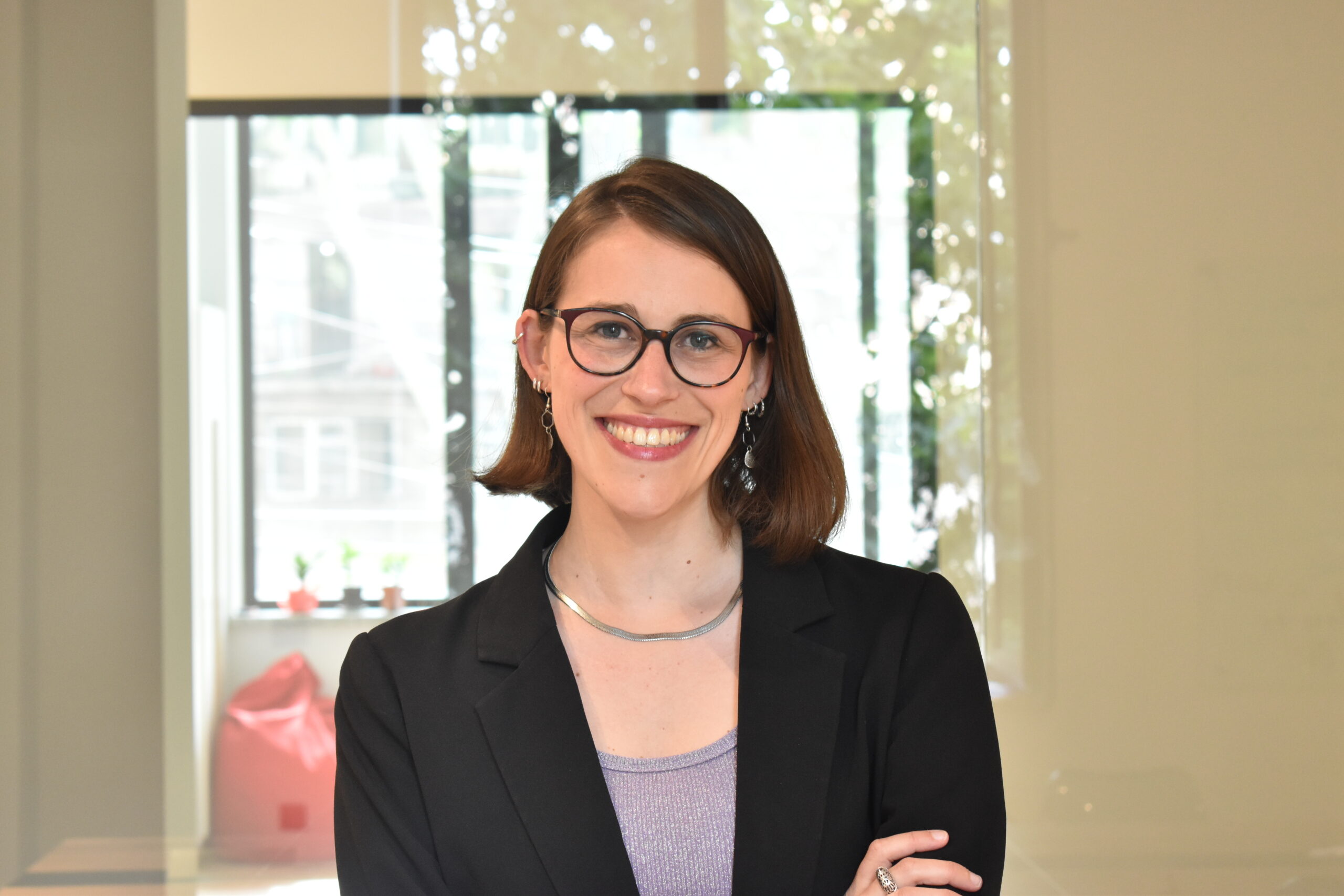
Laura Luciani, PhD, Ghent University, Belgium
A missing painting
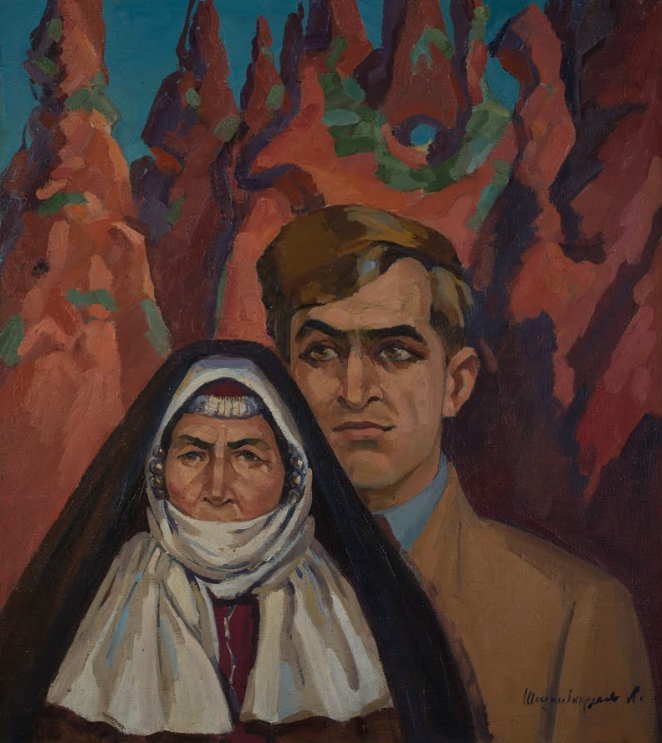
One highlight of my research stay in Armenia was a short trip to Goris, in the country’s southernmost province of Syunik. On May 18, International Museum Day, my friend H.P. and I were lucky enough to visit the house-museum of Aksel Bakunts, enjoy its blossoming garden and admire a pheasant living there – all for free.
While Bakunts’ life and writings were completely unknown to me, there was a special reason why my friend wanted us to visit the house-museum: to show me a painting by Mariam Aslamazyan – or the “Armenian Frida Kahlo.” But the portrait of Aksel Bakunts and his mother, which was supposed to hang in the writer’s bedroom, was not there. Disappointed, my friend asked the museum worker – a middle-aged woman who was following us throughout the visit – what had happened with the painting which just one year earlier was showcased in the same room.
The dialogue that followed was in Armenian, and despite not understanding the language I could sense from the museum worker’s heartbroken expression and my friend’s shocked reaction that something was not right. The woman explained that during the September 2022 Azerbaijani strikes on Armenia’s territory, including the Syunik province, the museum workers had asked their colleagues from Yerevan to come and collect Aslamazyan’s canvas and other valuable objects – “to bring them to a safe place.” She could not answer the question of when these artworks would be returned to Goris.
As we walked out from the museum, and throughout the rest of our stay in Goris, we could not get this random discovery off our minds. As a researcher visiting Armenia to conduct a study on local understandings of peace and security, I found myself grappling with a lot of questions: how do people live and cope with a permanent feeling of insecurity? How can security be created through mundane, everyday practices – like calling fellow museum workers in Yerevan to help rescue a painting and some old carpets at risk of being damaged by shelling? What do ordinary people care about and care for during violence, war and its aftermath?
Looking back at my month-long visiting fellowship at CRRC-Armenia, at the few days I spent doing research in Syunik, and at the interviews I conducted with NGO workers, activists, scholars and experts in Yerevan and beyond, I feel like I only started unearthing some of the answers.
Building ‘resilience’
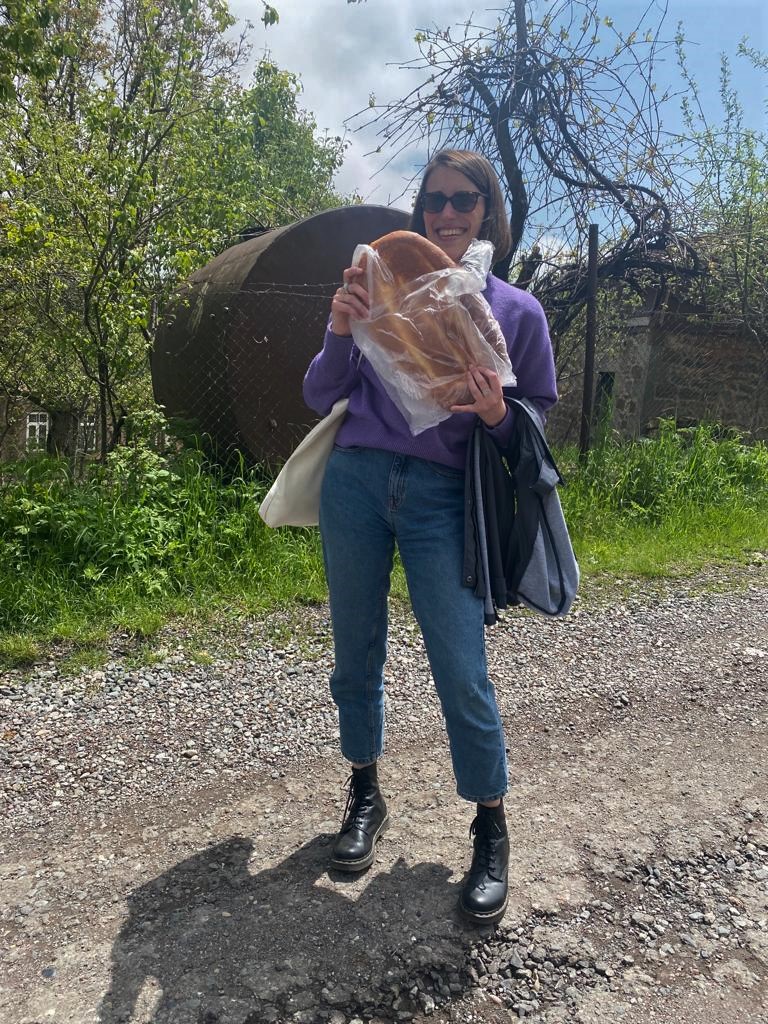
The original goal of my trip to Syunik, which my friend enthusiastically decided to join so that she could escape from Yerevan for a while, was to attend and observe a series of events organized by the EU Delegation in the framework of Europe Day 2023. I had arrived in Yerevan just a couple of days earlier and barely had the time to get to know colleagues at CRRC-Armenia, introduce myself and my work during the Academic Lab on a Wednesday morning. A few hours later, we were sitting in a marshrutka, off to a 4-hour careless drive with destination: Goris.
Despite the rain and cold we encountered at our arrival, the next morning the sun was shining over Goris’ cliffs and lushy green hills; as we set off to walk to the city center, chatting and laughing in French, we arouse the curiosity of a local resident who stopped his small van to gift us with a freshly baked matnakash.
We spent the rest of the morning trying to figure out how to reach Kapan to attend an EU-sponsored public fair dedicated to ‘resilience’. Since the 2020 Nagorno-Karabakh war, Azerbaijan regained control of territories along and across the main road that connects Goris and Kapan. Reconstruction works on an alternative route linking the two cities via the town of Aghvani, further away from the disputed Armenian-Azerbaijani border, have started in 2021. However, the road was still in awful condition and only one minibus per day was travelling there.
Once we finally made it to Kapan’s cultural centre, we were welcomed by schoolkids dancing in traditional clothes, parents cheering and taking videos, loud music and a series of stands where workers of local and international NGOs distributed leaflets and gadgets to promote EU-funded projects in the region.
The Resilient Syunik Team Europe Initiative, launched in January 2023, was in the spotlight: with a five-year budget of €116 million, the initiative aims to support the “sustainable socioeconomic development” of Syunik within “a changing geopolitical landscape” – on the way to build “sustainable peace in the region.” The focus is on the development of the private sector and SMEs, small-scale infrastructure recovery and, to a lesser extent, the provision of community-based social services.
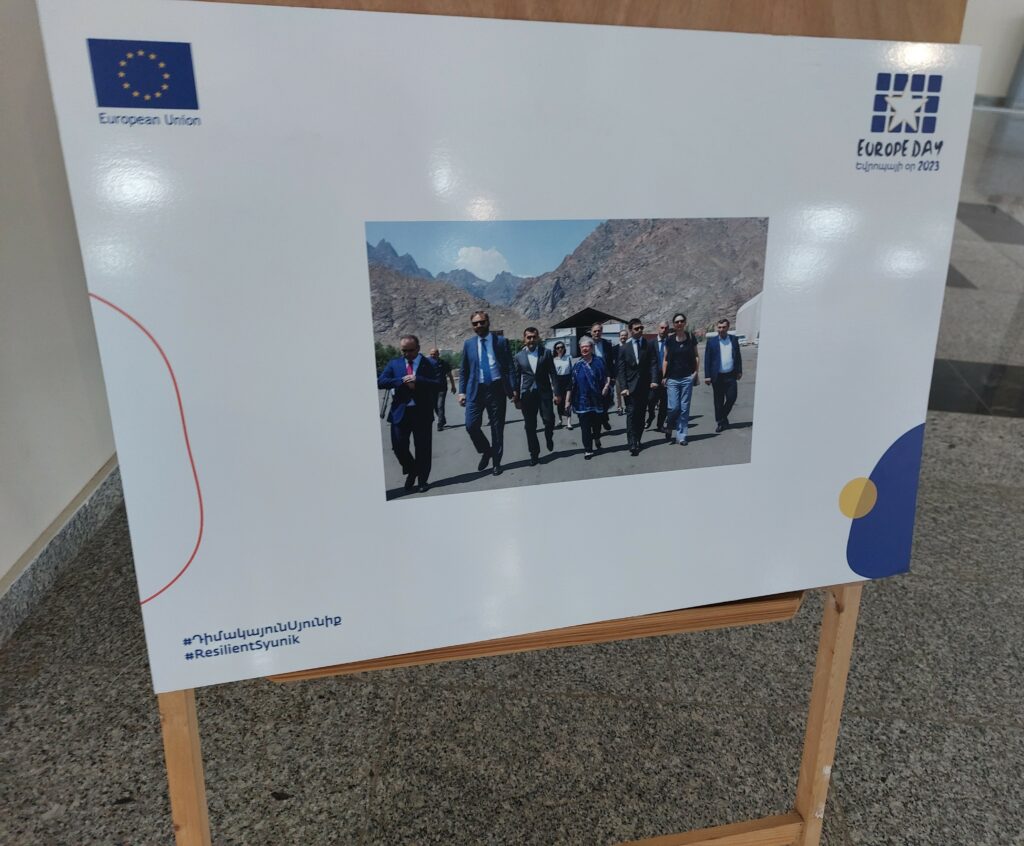
Civil society representatives I spoke with in Armenia saw these investments as a message of hope for Syunik residents in a context of heightened insecurity. Local political figures believe that the initiative expresses EU support for Armenia’s territorial integrity in response to Azerbaijan’s aggressive politics.
Wandering around the fair, I was amused by the photo of a group of EU ambassadors paying a visit to Syunik (presumably, shortly after the September 2022 attacks): a printed cardboard sheet serving as a spectacle of the EU’s role in providing security and protection to Syunik people. “If the region was not safe, ambassadors would not visit, would not spend all this money on projects,” several research participants told me.
The next day, vehicles and monitors from the newly established EU mission in Armenia (EUMA) were stationed in front of the hotel in Goris where a panel discussion with local social workers was taking place. The EUMA presence at the event was another way to raise the visibility of the EU’s efforts in “contribut[ing] to security of people in conflict affected areas of Armenia.”
The everyday of interventions
In recalling my impressions from this research trip, I think about the question raised by feminist scholar Shine Choi: “what does it mean to desire peace in the context of shared international predicaments of being continually rendered objects of international intervention through the “conflict zone” framework?”
On our last afternoon in Goris, we enjoyed a delicious lunch in a hotel restaurant overlooking the hills and the old city. The owner chatted with us as we were eating. He shared his distrust vis-à-vis the “European money” which is being poured into the region. He would like his business to thrive thanks to his own skills and local resources, without partaking in any kind of “Euroremont”.
Choi writes that the Euro-American-led imposition of conflict resolution frameworks – experienced as an inescapable phenomenon in the everyday lives of individuals – creates “all kinds of contradictory desires and attachments with ‘the international community’ that offer solutions for ‘conflict zones’ where some subjects matter only in their object-ness and local lives are ultimately expendable in the name of keeping peace.”
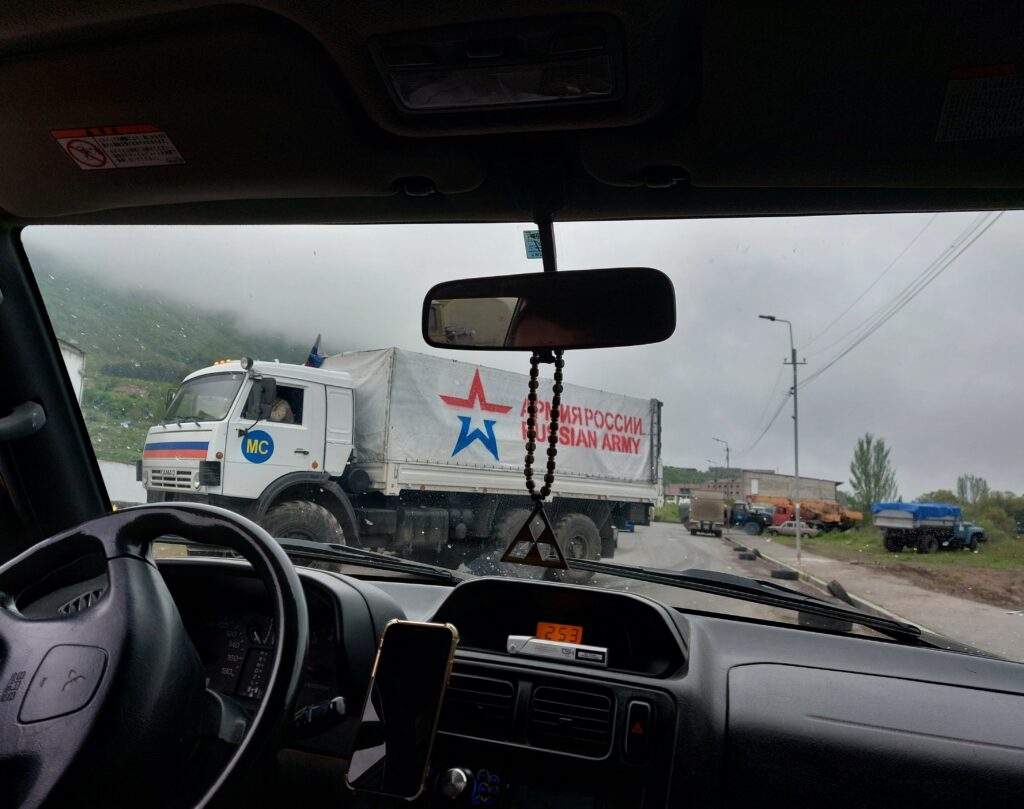
In Goris, these solutions and manifestations of geopolitical power do not emanate solely from the leaflets, photographs and monitoring vehicles with the omnipresent twelve-golden-stars-against-a-blue-background logo. Competing geopolitical interests are experienced and contested in people’s everyday lives.
In a taxi going back to our guesthouse, we crossed paths with a truck belonging to the Russian army. The young driver decided to show us the base where part of the 2,000-strong Russian peacekeeping force, tasked with securing Nagorno-Karabakh and the Lachin corridor, is stationed in Goris. From there, Russian peacekeepers have been providing a minimum level of humanitarian assistance and food supplies to blockaded Karabakh. “The Russians aren’t doing anything,” the driver commented bluntly, without us even having to ask the question: “only us, Armenians, can protect ourselves.”
My visiting fellowship at CRRC-Armenia was a great opportunity to witness the hectic day-to-day work of a research centre and learn from a committed group of scholars and analysts. Through formal and informal conversations with colleagues at CRRC, by observing focus groups discussions with Yerevan residents and by participating in a conference on global security and human rights, I was exposed to a variety of perspectives that enriched and also challenged my understandings of conflict, peace and (in)security in Armenia and beyond. I am heading back to Belgium with plenty of vivid memories as well as fieldnotes, recordings, pictures and literature to work on – as I try to make further sense of these rough sketches from my research trip to Goris.
Laura Luciani is a postdoctoral researcher at the Ghent Institute for International and European Studies, Ghent University in Belgium. Her research interests include the local effects and negotiations of international interventions, with a focus on the South Caucasus region and EU foreign policies, gender and sexuality in international relations, postcolonial critiques and interpretive methodologies. She received her PhD degree in Political Sciences from Ghent University in 2022. Previously, Laura interned at the European Endowment for Democracy and was a freelance writer with Italian media outlets focused on Eastern Europe and Eurasia. She is also a co-convener of International Political Sociology (IPS) Belgium.